Data extracted in January 2025.
Planned article update: January 2026.
Highlights
The railway network in the EU shrunk by 1.3% between 2013 and 2023. In contrast, it increased by 8.9% in Lithuania. In Spain the increase of 5.2% is due in large part to the construction of dedicated high-speed lines.
In 2023, the densest railway networks in the EU were in Czechia (123.2 metres of railway line per square kilometre) and Belgium (119.2); Greece (14.0) and Finland (19.4) had the lowest network densities.
In 2023, Luxembourg had the highest share of electrified railway lines in the EU, with 96.7%, followed by Belgium (88.0%) and Sweden (75.1%), each with shares well above the EU average of 57.4%.
In 2023, there were 8 556 km of dedicated high-speed railway lines in the EU, with Spain and France together accounting for close to three quarters of the dedicated EU high-speed network. The high-speed network in the EU has grown by 47.2% since 2013.
- Electrified railway lines, 2023 (% of total length of railway lines)
Source: Eurostat (rail_if_line_tr)
- Electrified railway lines, 2023 (% of total length of railway lines)
An efficient, secure and interoperable railway infrastructure is essential for sustainable transport of persons and freight across Europe, ensuring reliable and low-emission production chains and mobility. The railway infrastructure is an important component of the Fit-for-55 programme's sector policies on transport, aimed at meeting the transport sector's targets as part of the European Green Deal.
This article presents data on different characteristics of the railway network in Europe. The data generally cover the European Union (EU) countries, the EFTA countries and the candidate countries and one potential candidate. The article also presents data on the development in the length of the railway network in Europe and on its density. It provides information on the development in electrification of the network, as well as in its capacity through increases and decreases in the length of lines with two or more parallel tracks. Information on tracks with different track gauges are also provided. A special section is dedicated to the development of high-speed railway lines.
Finally, the article looks into level crossings on the railway lines, and lines equipped with the European Rail Traffic Management System (ERTMS), 2 important issues for railway safety. Here only the EU countries and EFTA countries are covered, as the data come from the European Agency for Railways (ERA).
Metro, tram and light rail urban lines are not included in the railway statistics.
Developments in the extent and density of the national railway networks
In 2013, the railway network in the EU amounted to 203 568 km of railway lines. By 2023, it had decreased to roughly 200 947 km, corresponding to a decline of 1.3%. However, the trend in the length of national networks differed substantially between the different EU countries (see Figure 1).
Among the EU countries, Lithuania recorded the largest expansion of its railway network between 2013 and 2023 in relative terms (+8.9%; +157 km), while in actual length Spain had the highest increase (+802 km; +5.2%).
In contrast, the national networks were considerably slimmed down from 2013 to 2023 in Greece (-29.5%; -764 km) and France (-9.6%; -2 934 km), one of the largest national railway networks in the EU. In Germany the length of the national railway network in 2023 was 38 691 km, similar as in 2013 (38 653 km).
There were also large differences among the candidate countries over the same period. While Türkiye recorded a strong increase in its railway network (+17.5%; +1 699 km), stimulated amongst others by the building of new high-speed lines, Georgia saw the length of its railway lines reduced by -31% (-501 km), Albania by -26.9% (-93 km) and Serbia by -11.4% (-437 km).

(index 2013=100)
Source: Eurostat (rail_if_line_tr)
Railway networks and other transport networks tend to be concentrated in and around main cities and other population hubs, while there are fewer railway lines in areas with low population and limited industry. Thus, the density of the railway network, measured in metres of railway line per km2 land area, overall tends to be lower in countries with large less-populated regions. Map 1 provides a picture of the railway network density in Europe.
Within the EU, the countries with the highest density of railway network are all situated in the centre of northern Europe, reflecting both their high population density and relatively high volumes of freight transport. In 2023, Czechia had the highest railway network density with 123.2 metres of railway lines per km2. Other EU countries with high density were Belgium (119.2 m/km2), Germany (109.5 m/km2) and Luxembourg (104.8 m/km2), far above the EU average of 49.0 m/km2.
Lower densities are reported for EU countries on the outskirts of the EU. Greece had the lowest railway network density, with 14.0 m/km2. Low densities were also recorded in the Nordic countries (Finland 19.4 m/km2; Sweden 26.8 m/km2), the Baltic countries (Estonia 27.2 m/km2, Latvia 28.9 m/km2, Lithuania 30.7 m/km2), the Iberian peninsula (Portugal 27.8 m/km2, Spain 32.1 m/km2) and Ireland (29.8 m/km2).
The EFTA countries are strong contrasts to each other with respect to their railway network density. Norway had a lower density than any of the EU countries, at 10.7 m/km2 in 2023, explained by its low population density. In Switzerland, the density lay at 133.4 m/km2, higher than in any country in the EU.
Generally, the railway networks are not very dense in the candidate countries and the potential candidate. Their densities range from 9.0 m/km2 in Albania and 14.9 m/km2 in Türkiye to 44.0 in Serbia and 34.2 in Ukraine (2020 data).
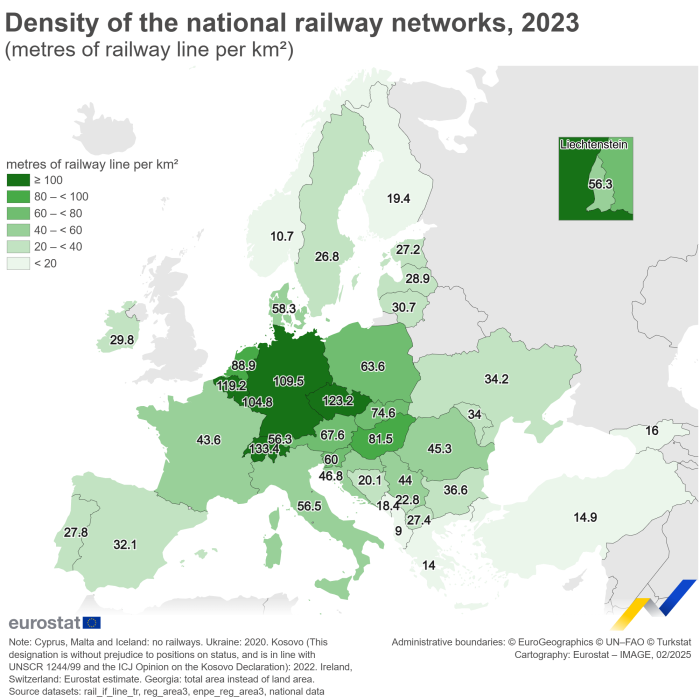
(metres of railway line per square kilometre land area)
Source: Eurostat (rail_if_line_tr) for length of railway lines; (reg_area3), (enpe_reg_area3) and national data for geographical area
Electrification is a key element of the modernisation of railway networks, substantially lowering the negative environmental impact of railway transport compared with road transport and other transport modes heavily dependent on fossil fuels. Non-electrified railway lines are mainly operated by diesel locomotives and railcars. Figure 2 shows the development in the electrification of the railway network in the EU and for selected countries with notable electrification levels or developments.
Over the period from 2013 to 2023, there was an increase in the electrification of the lines of the European railway network. Whereas 53.8% of the railway lines in the EU were electrified in 2013, this share had increased to 57.4% by 2023. This corresponds to an increase of 3.6 percentage points (pp). The strongest increase took place in Greece, where the electrification rate rose from 16.9% to 40.5%, an increase of 23.6 pp. Other EU countries that advanced considerably over this period were Denmark (+10.2 pp), France (+8.9 pp), Slovenia (+8.7 pp), Portugal (+6.9 pp), as well as Spain (+5.9 pp).
Among the candidate countries, in Türkiye the share of electrified railway lines increased from 30.1% in 2013 to 56.5% in 2023, up 26.4 pp.

(% of total length of railway lines)
Source: Eurostat (rail_if_line_tr)
As shown in Map 2, Luxembourg has by far the highest level of electrification within the EU. In 2023, 96.7% of the railway lines in Luxembourg were electrified, reflecting its drive to electrify its railway network in the 1990s. Belgium also had a high degree of electrification, with 88.0% in 2023. Other EU countries with high electrification rates are Sweden (75.1%), Bulgaria and the Netherlands (both 74.5%).
In Ireland, only 53 kilometres of its railway lines were electrified by 2023, making up a share of only 2.6% of the railway network in the country. Also in the Baltic countries, the electrification rate is low, with 7.9% in Lithuania, 12.0% in Estonia and 13.7% in Latvia.
In other parts of Europe, Switzerland stands out with an almost complete electrification of its national railway network (99.8% in 2023). Among the candidate countries and the potential candidate, Georgia (98.4%) and Montenegro (90.5%) both have a high degree of electrification, whereas Albania, Moldova and Kosovo*[1] report no electrified railway lines.
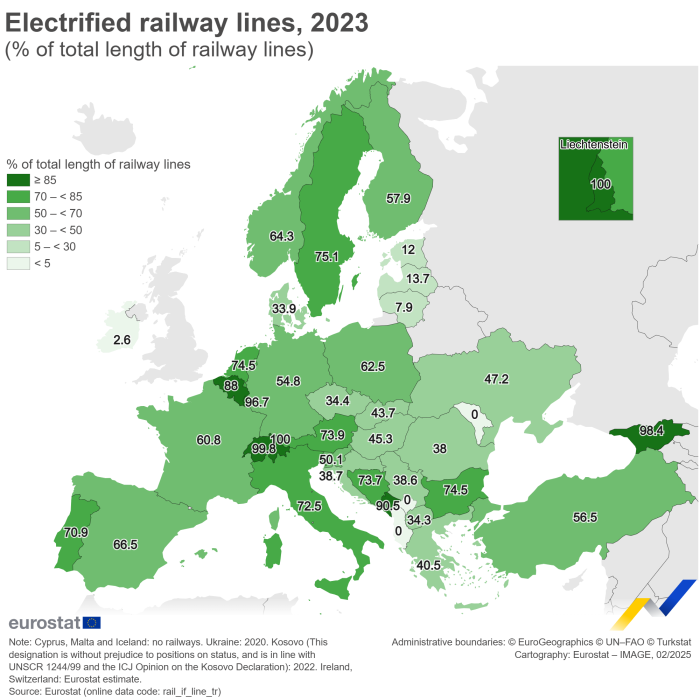
(% of total length of railway lines)
Source: Eurostat (rail_if_line_tr)
Electrified railway lines by type of current
One important characteristic of the electrified railway network is the type of current. In Europe, the following main types of electric current are in use: Alternating Current (AC) 50 Hz / 25 000 Volts, AC 16 2/3 Hz / 15 000 Volts, Direct Current (DC) 3 000 Volts and DC 1 500 Volts.
In the European Union the share of the first 3 above-mentioned types of current is about 30% each (31.8%, 28.1% and 31.5%, respectively) while the share of DC 1 500 V is about 7.7% (Table 1).

(km)
Source: Eurostat (rail_if_electri)
Alternating current is predominantly used in Bulgaria, Greece, Lithuania, Luxembourg, Romania, Finland and Sweden (all electrified railway lines are ‘run’ there with AC), Croatia (99.7% of the electrified railway lines), Portugal (98.6%), Germany and Hungary (both 96.6%) and Austria (93.1%) (Map 3). The share of AC is also significant in Denmark (79.4%) and in France (65.4%). In contrast, in Estonia, Ireland, Latvia and Poland AC is not used at all; in those countries direct current is used exclusively. The use of AC is also insignificant in Slovenia (1.5% of total electrified railways lines operates with AC) and in Italy (6%), while it is quite small in the Netherlands (12.7%) and Belgium (14.6%).

(% of total length of railway lines)
Source: Eurostat (rail_if_electri)
When it comes to main type of alternating current, out of 21 EU countries where AC is used, AC 50 Hz / 25 000 V is the main type of current in 18 countries, while AC 16 2/3 Hz / 15 000 V is predominantly used only in Germany, Austria and Sweden (Map 4). Among the countries where DC is exclusively used, the main type of current is DC 3 000 V in Estonia, Latvia and Poland. Ireland is the only EU country where electrified railway lines (53 km) are operated by DC 1 500 V only; the most important contributors to DC 1 500 V network are anyway France (5 705 km) and the Netherlands (1 979 km) (Table 1).
In all 3 EFTA countries the share of the AC 16 2/3 Hz / 15 000 V is dominant, while in most of the candidate countries the main type of current used by electrified railway lines is AC 50 Hz / 25 000 V. Exception is Georgia where all electrified railway lines use DC 3 000 V and Ukraine where about half (47%) of the electrified railway lines are operated with DC 3 000 V (Table 1). In Moldova, Albania and Kosovo, there are no electrified railway lines.
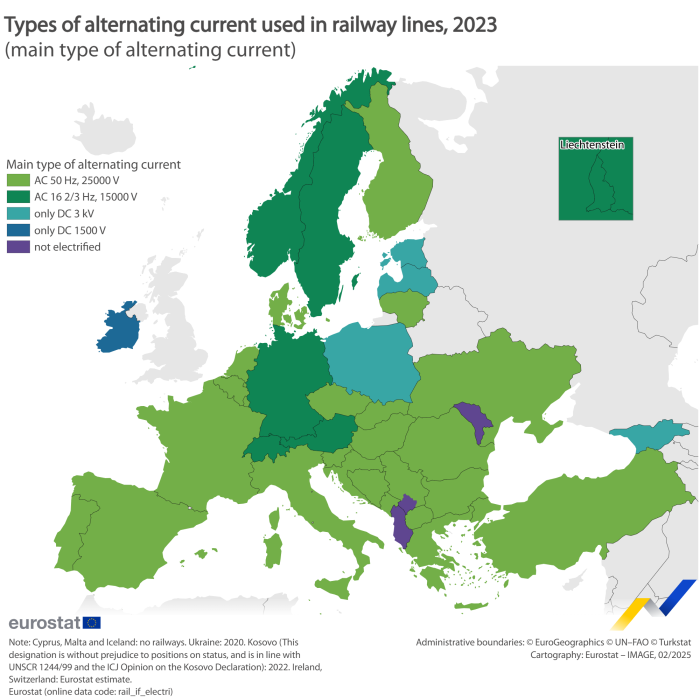
(main type of alternating current)
Source: Eurostat (rail_if_electri)
Increased capacity through expansion of lines with 2 or more tracks
In addition to the length of the railway lines, an important aspect of the capacity of national railway networks is the share of lines with 2 or more parallel tracks. Multiple parallel tracks enable more efficient and higher levels of traffic on the railway lines, increasing flexibility and reducing the effects of any disturbances. Figure 3 highlights the development in lines with 2 or more parallel tracks in the EU and in selected countries that stand out.
Over the last decade, the capacity of the EU railway network has improved, with the share of lines with 2 or more parallel tracks growing from 38.7% in 2013 to 40.8% in 2023, an increase of 2.1 pp. This represented an additional 3 142 km of railway lines equipped with 2 or more tracks over the period. In Greece, the share of lines with multiple tracks expanded strongly, from 20.2% in 2013 to 34.8% in 2023 (+14.6 pp; +111 km). This share also increased considerably in France (+7.3 pp) and Denmark (+6.9 pp). In absolute numbers, the lines with 2 or more parallel tracks grew most in Spain (+830 km), Germany (+457 km), France (+382 km) and Austria (+228 km).
In contrast, between 2013 and 2023 the share of the railway lines equipped with 2 or more tracks declined slightly in Slovenia (-0.4 pp).

(% of total length of railway lines)
Source: Eurostat (rail_if_line_tr)
A certain difference with respect to the share of railway lines with 2 or more parallel tracks can be seen between countries in the north, east and furthest west of the EU and countries in the middle and south (see Map 5). The highest shares of railway lines with multiple tracks are found in Belgium (80.8%) and the Netherlands (70.5%). Both countries are characterised by a relatively small land area, high population density and high levels of freight transport to and from important seaports (Rotterdam and Amsterdam in the Netherlands; Antwerp in Belgium). France (62.7%), Luxembourg (59.0%), Germany (48.3%) and Italy (46.0%) also has national networks with a high share of lines with 2 or more parallel tracks.
The lowest shares of railway lines with multiple tracks are found in Estonia (9.4%) and Croatia (10.5%). Low shares are also found in the Nordic countries Finland (12.1%) and Sweden (19.1%) and in eastern countries such as Hungary (18.2%) and Latvia (20.1%).
Among other European countries, Norway is similar to its Nordic neighbours Finland and Sweden in this aspect. Its share of 8.0% railway lines equipped with multiple tracks is lower than in any of the EU countries. Even lower rates are found in some of the candidate countries and the potential candidate. Montenegro, North Macedonia, Albania and Kosovo are not reporting any railway lines with multiple tracks. Moldova reported a share of 6.4% in 2023.
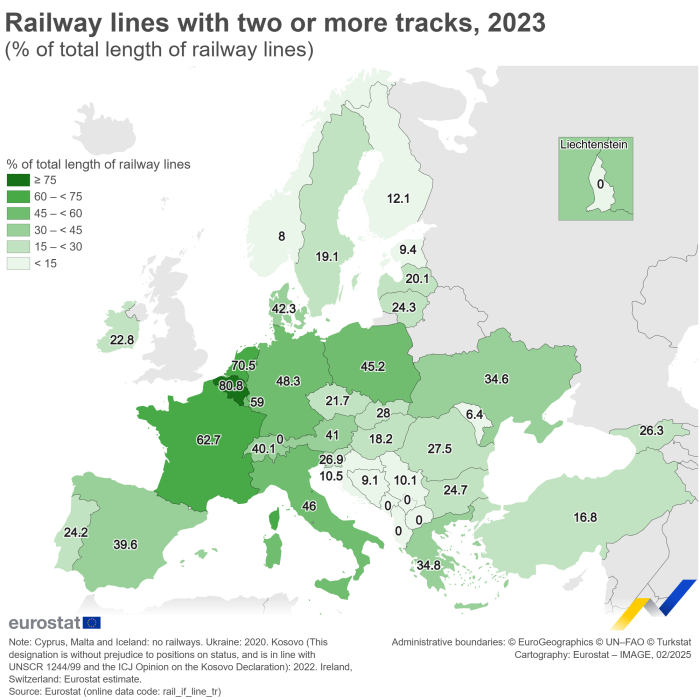
(% of total length of railway lines)
Source: Eurostat (rail_if_line_tr)
Track gauge: an important feature for interoperability of railway networks
One important characteristic of the railway network with respect to connectivity and interoperability is the width of the tracks, known as track gauge. The track gauge is the smallest distance between a pair of rails, measured between the inside of the rail heads. Generally, one distinguishes between 'large gauge' railway tracks (more than 1 435 mm width), 'standard gauge' (1 435 mm) and 'narrow gauge' (less than 1 435 mm).
Lines with narrow track gauge play only a marginal role in the EU railway network, with a share of only 1.5% in the total length of the network in 2023. However, narrow gauge lines are still of some importance in some countries.
The most striking development over the period 2013-2023, illustrated in Figure 4, took place in Greece, where the share of lines with narrow track gauge decreased from 28.9% in 2013 to 4.6% in 2023 (-24.3 pp), mainly through sharp falls in 2014 and 2022. Austria retained one of the higher shares of narrow-gauge lines with 6.7% of the total network in 2023, compared with 5.6% in 2013, a slight increase of 1.1 pp. However, within this period, the share lay at between 5.4% and 5.6% between 2013 and 2018. Similarly, Spain reported an apparent increase in the share of narrow-gauge lines over this period, from 7.9% in 2013 to 9.4% in 2023.
Among other European countries, Switzerland stands out with a number of narrow-gauge lines in its mountain regions. These narrow-gauge lines make up slightly over a quarter of the Swiss railway network, remaining relatively stable over the period. Only a slight decrease has been recorded, down 0.3 pp from 26.2% in 2013 to 25.9% in 2023.

(% of total length of railway lines)
Source: Eurostat (rail_if_line_ga)
Generally, few railway lines with narrow track gauge still exist, most of them in mountainous regions. They often become heritage lines being operated as museum or touristic lines. Today, modern narrow track gauges are mainly operated in local tramway networks, which are out of the scope of the railway statistics.
Large track gauge is also still in use in some EU countries: it is predominantly used in Estonia, Ireland and Finland (in all 3 all railway lines are of large track gauge), Latvia (98.2% of the railway lines), Portugal (96.2%) and Lithuania (93.3%) (Map 6). The share of large track gauge is also significant in Spain (71.1%). In Hungary, Romania, Slovakia and Poland large track gauge can also be found but their share in total railway lines ranges between 0.6% and 2.9%.
In the EFTA countries, large track gauge is not used at all. In the candidate countries and potential candidate, large track gauge is used only in Georgia (all railway lines), Ukraine (98.3% of total railway lines, 2020 data) and Moldova (93.2%).
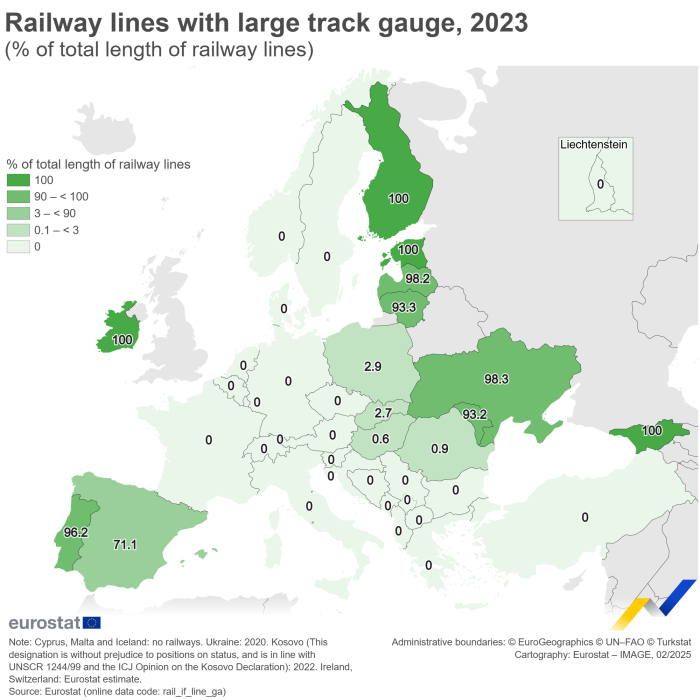
(% of total length of railway lines)
Source: Eurostat (rail_if_line_ga)
The European network of dedicated high-speed railway lines is expanding but with only 1 new Member State in the last 10 years
An important target of European policies is to reduce the environmental impact of the transport sector and its emissions of greenhouse gases. In this context, the steady expansion of the interconnected high-speed railway network across Europe is a vital contribution towards strengthening rail travel as an alternative to travel by road and air, which cause substantially higher CO2 and greenhouse gas emissions per passenger-kilometre.
Dedicated high-speed railway lines are railway lines specifically built to allow traffic at speeds of 250 km/h or greater on their main segments. Figure 5 shows how, over the 10 years from 2013 to 2023, the network of dedicated high-speed railway lines in the EU expanded considerably, by 2 744 km (+47.2%) from roughly 5 800 km to just over 8 500 km. This high-speed network is interoperable across the EU, with connections operating across national borders.
This rapid progress is mainly attributable to the expansion of the dedicated high-speed lines in Spain and France, which together make up close to three quarters of the high-speed network in the EU (Spain 37.3%; France 32.1%). From 2013 to 2023, the high-speed network in Spain grew from 1 919 km to 3 190 km (+1 271 km; +66.2%), becoming the most important network in Europe, while this in France grew from 2 036 km to 2 748 km (+712 km; +35.0%). The dedicated high-speed network in Germany grew from 881 km to 1 163 km over the same period (+282 km; +32.0%), while that in Italy increased from 638 km to 734 km (+96 km; +15.0%). For the other EU countries with dedicated high-speed lines, there were only limited changes: the network in Belgium and in the Netherlands stayed unchanged at 211 km and 90 km, respectively. Denmark opened its first 57 km of dedicated high-speed lines in 2019.
Among the candidate countries, Türkiye was the only one with specifically built high-speed railway lines, increasing from 888 km in 2013 to 1 978 km in 2023 (+1 090 km; +122.7%).
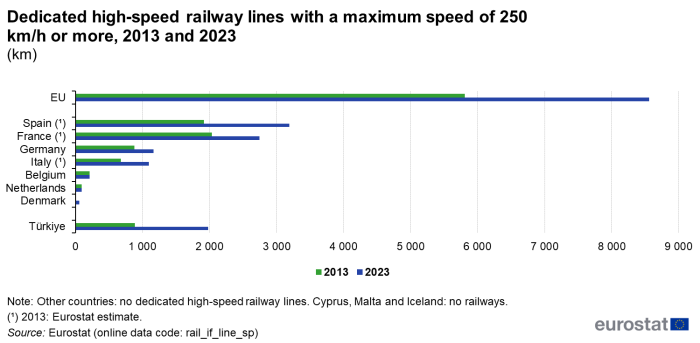
(km)
Source: Eurostat (rail_if_line_sp)
As mentioned, Spain, France, Germany, Italy, Belgium, the Netherlands and Denmark are the only EU countries with dedicated high-speed railway lines. Although these networks are vital to strengthening rail travel as an environment- and climate-friendly alternative primarily to road and air travel, the shares of the dedicated high-speed lines within the national railway networks are more limited. The share in Spain lay at 19.8% of the total length of the national railway network in 2023. In France, the share stood at 10.0%. In the other EU countries with dedicated high-speed lines, the shares ranged between 6.5% in Italy to 2.3% in Denmark. In Türkiye, the dedicated high-speed lines made up 17.3% of its national railway network in 2023.
Level crossings on railway tracks remain an important safety issue
An intersection where a road is crossing a railway track, at 'street level', is called a level crossing. The crossing should be authorised by the responsible manager for the railway infrastructure and be open to all users of the road. There are two types of such level crossings: active level crossings and passive level crossings. An active level crossing is equipped with devices that are activated when it is unsafe to cross the railway tracks. These devices include physical protections such as barriers and gates, as well as warning signals such as lights, bells, horns, klaxons, etc. Passive level crossings are rail track crossing points without any active devices to protect or warn users.
A main challenge for railway safety is to reduce the number of level crossings, as cars, cyclists, pedestrians and other road users may come into direct contact with trains and other rolling stock. Indeed, accidents at level crossings is one of the main categories of railway accidents, both with respect to the number of persons killed and the number of accidents.
The main strategies for reducing the risk of accidents between road users and railway rolling stock is to construct underpasses or tunnels for the roads or the rail tracks in order to eliminate level crossings, as well as converting passive level crossings into active ones through installation of active devices to protect and warn. Information on the number of level crossings, as well as of the number of level crossings equipped with the different types of active safety devices, are part of the Common Safety Indicators (CSI) compiled by the European Union Agency for Railways (ERA). Data on railway safety and accidents, sourced from the ERA, are available in Eurostat's database: Transport, see the dataset collection 'Rail transport safety (tran_sf_rail)' under 'Transport' / 'Transport safety (tran_sf)'.
Between 2013 and 2023, the total number of level crossings in the EU decreased by 11.4% (from 104 865 to 92 890). The number of level crossings were significantly reduced over this period in Greece (-55.7%), the Nordic countries Denmark (-30.4%), Finland (-29.6%) and Sweden (-18.3%), as well as in Austria (-29.3%). In absolute number of level crossings, the numbers fell most in France (-2 774; -16.3%), followed by Poland (-1 528; -11.2%) and Sweden (-1 505; -18.3%).
However, the number of level crossings are typically more prevalent on railway lines in regions with lower population density and thus less road traffic crossing the railway lines. Closures of railway lines in such regions may have a certain impact on the overall number of level crossings. Thus, from a safety perspective, it may often be more interesting to analyse the number of level crossings, and passive level crossings in particular, relative to the length of railway lines operated.
Figure 6 presents the development from 2013 to 2023 in the number of level rail track crossings per 100 kilometres railway line, in the EU and in the EU Member States and EFTA countries. In 2023, there were on average 46.2 level crossings per 100 km railway line in the EU, down from 51.5 in 2013 (-10.3%). The highest prevalence of level crossings per 100 km railway line in 2023 was found in Czechia (81.3), followed by Hungary (81.2) and the Netherlands (72.9). Between 2013 and 2023, the number of level crossings relative to the length of the network was reduced by 37.1% in Greece, from 58.0 level crossings per 100 km line in 2013 to 36.5 in 2023. Other EU countries that were able to substantially reduce the relative number of level crossings over this period were Austria (-29.9% to 58.0 level crossings per 100 km line in 2023), Finland (-29.2% to 41.7 in 2023) and Denmark (-25.6% to 35.8 in 2023).
Norway had a higher number of level crossings per 100 km railway line than any of the EU countries, with 81.6 in 2023.
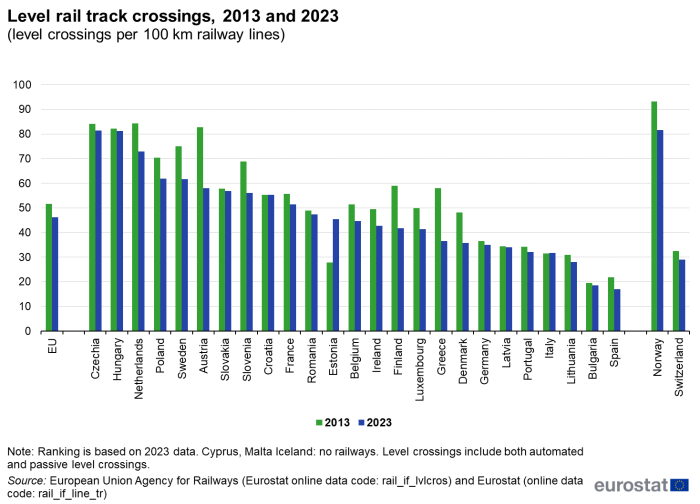
(level crossings per 100 km railway lines)
Source: European Union Agency for Railways (Eurostat online data code: (rail_if_lvlcros)) and Eurostat (online data code: (rail_if_line_tr))
When it comes to reducing the number of passive level crossings, the progress has been even more pronounced. Between 2013 and 2023, the number of passive level crossings in the EU were reduced by more than one fifth, from 47 404 to 37 337 (-21.2%). In absolute numbers, the largest reductions were achieved in Poland (-2 486; -28.9%), Sweden (-1 608; -32.0%), Austria (-1 189; -44.3%) and Finland (-984; -36.1%). Denmark reduced the number of passive level crossings by 70.2% over the period. Other EU countries with substantial reductions were Luxembourg (-64.5%) and Greece (-61.9%). This achievement in reducing the number of passive level crossings is reflected in the sharp reduction in accidents at level crossings, which fell by 19.9% over the same period.
In 2023, there were on average 18.6 passive level crossings per 100 km railway line in the EU (see Map 7), down from 23.3 in 2013 (-20.2%). The highest prevalence of passive level crossings per 100 km railway line were found in Hungary (42.2) and Czechia (35.6). There were also relatively high numbers of passive level crossings in Romania, Croatia, Sweden, Poland and Ireland, with between 32.3 and 30.4 per 100 km railway line.
The EFTA countries Norway and Switzerland stood out compared with the EU countries. In 2023, Norway had 69.2 passive level crossings per 100 km railway line, higher than any of the EU countries; Switzerland, with 2.5 passive level crossings per 100 km line, had a lower prevalence than any EU country. This reflects the low railway network density in Norway and high density in Switzerland, respectively.

(number per 100 kilometres railway lines)
Source: European Union Agency for Railways (Eurostat online data code: (rail_if_lvlcros)) and Eurostat (online data code: (rail_if_line_tr))
Railway lines equipped with ERTMS
The installation of Train Protection Systems (TPS) is widely considered one of the most effective railway safety measures for reducing the risk of collisions between trains. TPS are non-interoperable legacy systems, also known as class B systems, with varying functions, reliability and accuracy, depending on when they were installed, while the European Rail Traffic Management System (ERTMS) is the most advanced class A system. It is composed of train protection, radio communication and automated train operation. The ETCS is the standard European system for automatic train protection. Some Member States have decided to deploy ETCS on their entire rail network, thus going beyond the EU legal requirements (core, extended core and comprehensive TEN-T networks, 119 988 km in total at EU level, i.e. 60% of the global EU rail network).
The different ERTMS/ETCS application levels express the possible operating relationships between network and train: by track (ETCS Level 1) or by radio signal (ETCS Level 2). Out of 18 EU countries for which data on ERTMS deployment are available in 2024, the use of ETCS level 1 (track-based) signalling system was dominant in Bulgaria, Croatia, Luxembourg and Slovenia (all railway lines equipped with ERTMS use ETCS Level 1), Slovakia, Romania, Belgium and Spain (Table 2). By contrast, all railway lines that are equipped with ERTMS use ETCS Level 2 (radio-signal) in Czechia, Denmark and Sweden. Their share is also dominant in Germany, Hungary, Italy, France, Austria, Netherlands and Poland.
In Switzerland, the only EFTA country for which data are available, most railway lines that are equipped with ERTMS use ETCS Level 1.
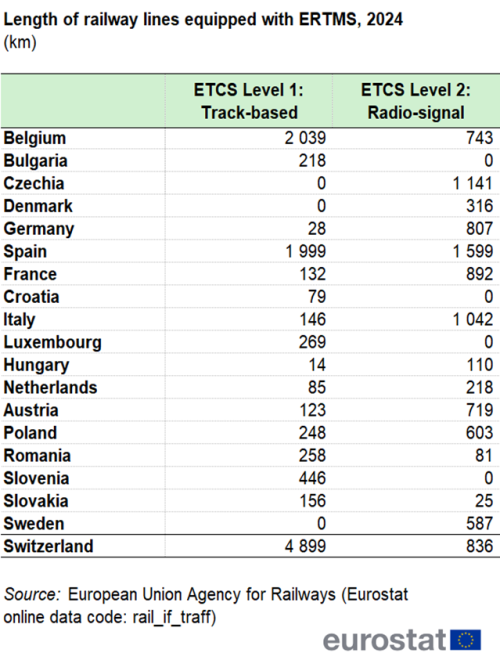
(km)
Source: European Union Agency for Railways (Eurostat online data code: (rail_if_traff))
The share of railway lines equipped with the railway traffic management system (ETCS Level 1 or 2) is quite different across Europe. Out of 18 EU countries for which data are available in 2024, their level is the most dominant in Luxembourg: 99.4% of the railway lines are equipped with ETCS Level 1 (track-based) signaling system, followed by Belgium with a share of 70.2% for the two levels and Slovenia with ETCS Level 1 (37.5%) (Figure 7). In contrast, such shares are the lowest in Hungary (1.9%), Germany (2.2%), Romania and Croatia (both 3.2%), Italy (3.6%), France (3.7%) and Poland (4.3%).
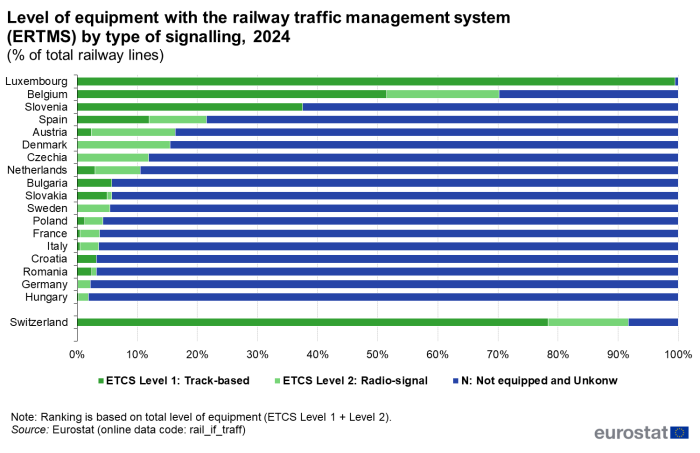
(% of total railway lines lines)
Source: European Union Agency for Railways (Eurostat online data code: (rail_if_traff))
Source data for tables and graphs
Data sources
Data collection
Statistics on railway infrastructure are mainly collected on a voluntary basis through the Eurostat / United Nations Economic Commission for Europe (UNECE) / International Transport Forum (ITF) Common Questionnaire on Inland Transport Statistics. The Common Questionnaire is based on a goodwill agreement with the participating countries. Eurostat, UNECE and ITF cooperate on coordinating and streamlining data collection at international level to reduce the administrative burden on national administrations, as many of the 58 reporting countries are members of more than one of the organisations.
Data is generally provided by the national statistical institutes or responsible transport administrations. However, methodologies are not harmonised at EU level, apart from the illustrated Eurostat/UNECE/ITF Glossary for Transport Statistics which harmonises definitions, thus comparability across countries may be restricted for certain topics or indicators. As data provision is voluntary, data may not be available for all EU Member States for each indicator. Thus, EU aggregates may be estimated or missing.
Eurostat cooperates closely with the European Union Agency for Railways (ERA) with respect to statistics on the European railway network. Eurostat publishes data provided by ERA on railway lines equipped with the ERTMS railway traffic management system issued from the Register of Infrastructure (RINF) and on level crossings, provided through ERA's Common Safety Indicators. An in-depth exchange of data with geographical coordinates has also been implemented between the Register of Infrastructure (RINF) managed by ERA and the technical characteristics of the railway network segments collected every 5 years through Regulation (EU) 2018/643, Annex V. This comparison of maps also has an impact on national aggregates.
Some additional data, filling in missing information for certain indicators (old time series, or in relation to high-speed lines), have been provided by the International Union of Railways (Union Internationale des Chemins de Fer: UIC), with which Eurostat exchange certain data and cooperate closely regarding definitions.
Coverage
The data in this article covers the EU Member States, the EFTA countries and the candidate countries and one potential candidate.
There are no railways in Cyprus, Malta and Iceland. There is only a minor railway network in Liechtenstein.
Definitions
All definitions of the indicators are taken from the illustrated Eurostat/UNECE/ITF Glossary for Transport Statistics, currently in its 5th edition (2019). This glossary can be found on Eurostat’s website. For the specific definitions related to railway infrastructure, see chapter A. Railway transport, sub-chapter A.I Infrastructure of the Glossary for transport statistics.
Context
The EU is committed to achieving climate neutrality by 2050, delivering on its commitments under the Paris Agreement. The European Green Deal aims to transform the EU into a fair and prosperous society with a modern and competitive economy. It is a package of policy initiatives, which includes initiatives covering the climate, environment, energy, transport, industry, agriculture and sustainable finance – all of which are strongly interlinked.
The transport sector currently accounts for a quarter of the EU's greenhouse gas emissions, of which 70% come from road transport. Investing in transport infrastructure, particularly in railways and inland waterways transport, contributes to the decarbonisation of transport. The European Green Deal sets a clear objective of reducing emissions from transport by 90%, compared with 1990 levels, by 2050. The European Commission's Sustainable and Smart Mobility Strategy and its action plan sets out 82 initiatives to reach this target.
Efficient transport services and infrastructure are vital to exploiting the economic strengths of the European Union, supporting the internal market and growth, and enabling economic and social cohesion. They also influence trade competitiveness, as the availability, price, and quality of transport services have strong implications on production processes and the choice of trading partners.
National rail networks have different technical specifications for infrastructure, which makes it more difficult and costly to run a train from one country to another. EU policies aim to overcome such differences. Creating an integrated European railway area thus requires better technical compatibility – 'interoperability' – of infrastructure, rolling stock, signalling and other characteristics of the rail system. Procedures for authorising the use of rolling stock across the EU's rail network also need to be simplified.
Eurostat's transport statistics are vital for monitoring EU transport policies and targets, providing key information in a coherent and reliable manner. Data are generally provided in accordance with the respective legal acts on statistics for the different transport. However, some important information is not covered by these legal acts, including information on the characteristics of the transport infrastructure. Comparable international data on railway infrastructure is instead collected on a voluntary basis through the Eurostat/UNECE/ITF Common Questionnaire on Inland Transport Statistics.
Footnotes
- * This designation is without prejudice to positions on status, and is in line with UNSCR 1244/1999 and the ICJ Opinion on the Kosovo Declaration of Independence. ↑
Explore further
Other articles
Database
- Transport, see:
- Railway transport (rail)
- Railway transport infrastructure (rail_if)
- Length of railway tracks by electrification of tracks (rail_if_tracks)
- Length of railway lines by number of tracks and electrification of lines (rail_if_line_tr)
- Length of electrified and non-electrified railway lines by track gauge (rail_if_line_ga)
- Length of electric and non-electric railway lines by nature of transport (rail_if_line_na)
- Length of electrified railway lines by type of current (rail_if_electri)
- Length of railway lines by maximum permitted speed (rail_if_line_sp)
- Length of railway lines equipped with the railway traffic management system by type of signalling (source: ERA) (rail_if_traff)
- Level crossings by type (source: ERA) (rail_if_lvlcros)
- Railway transport infrastructure (rail_if)
Thematic section
Publications
- All Eurostat transport publications online
- Key figures on European transport - 2024 edition
- Eurostat Regional Yearbook - 2024 edition
- European Commission – Directorate-General Mobility and Transport (MOVE): EU transport in figures: Statistical pocketbook 2024
- European Union Agency for Railways (ERA): ERA publications
Selected datasets
- Transport, see:
- Railway transport (t_rail)
- Total length of railway lines (ttr00003)
- Rail transport of passengers (ttr00015)
- Goods transport by rail (ttr00006)
Methodology
- Eurostat/United Nations Economic Commission for Europe (UNECE)/International Transport Forum (ITF): Glossary for transport statistics, 5th edition (2019)
- Eurostat/ITF/UNECE Common Questionnaire on Inland Transport Statistics (ESMS metadata file — rail_if_esms)
- Length of railway lines equipped with the railway traffic management system by type of signalling (source: ERA) (ESMS metadata file — rail_if_traff_esms)
External links
- United Nations Economic Commission for Europe (UNECE): Transport statistics
- European Commission – Directorate-General Mobility and Transport (MOVE): Rail and Infrastructure and Investment
- European Union Agency for Railways (ERA): Common Safety Method on Common Safety Targets and Registers of Infrastructure (RINF)
- International Union of Railways (UIC): RAILISA (RAIL Information System and Analyses) statistics
- European Environment Agency EEA): Transport and mobility
- European Climate, Infrastructure and Environment Executive Agency (CINEA): Connecting Europe Facility for Transport (CEF Transport)
Legislation
Statistics on railway infrastructure is collected on a voluntary basis through the Eurostat/ITF/UNECE Common Questionnaire on Inland Transport Statistics. The Common Questionnaire on Inland Transport Statistics is based on a goodwill agreement with the participating countries.
Rail transport statistics:
- Regulation (EU) 2018/643 of the European Parliament and of the Council of 18 April 2018 on rail transport statistics (recast)
Railway safety:
- Directive (EU) 2016/798 of the European Parliament and of the Council of 11 May 2016 on railway safety (recast)
European Union Agency for Railways:
- Regulation (EU) 2016/796 of the European Parliament and of the Council of 11 May 2016 on the European Union Agency for Railways and repealing Regulation (EC) No 881/2004
